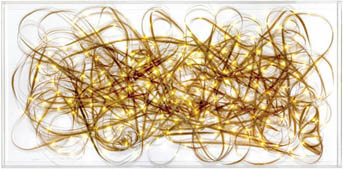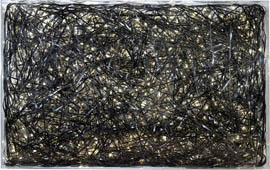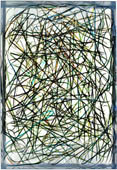|
|||||||
|
|||||||
Raymond Waters by Michael Zryd* Like much conceptual art, Raymond Waters’s work plays with the tensions that operate between objects and the social, political, and cultural discourses that surround them and invest them with meaning. Waters’s boxes showcase how value is attached to particular objects, upon which is projected monetary, patriotic, and cultural value—and of course, the commodity value that is artificially generated in the art market. In the case of Five Hundred Dollars (2006), which presents shredded US currency, Waters points to the remarkable parallels between currency and art objects apart from their shared relationships to commodification. Like a traditional painting, each dollar bill is authorized by signature (the Treasurer of the United States and the Secretary of the Treasury). Like an art multiple (e.g., a lithograph), each dollar bill is individually numbered. These guarantees of authenticity and uniqueness further index monetary value, which is in turn a symbolic value (for a particular fraction of gold held in Fort Knox, for instance). In the same way that monetary value is projected upon the little pieces of paper that make up currency, so enormous patriotic value is projected onto the US flag. The flag is a state-sanctioned configuration of stars and stripes that, unlike the dollar’s specifications of size (15.3 x 6.5 cm), paper type, and printing process, can be scaled to enormous extremes and printed on practically any receptive surface (textiles, paper, stickers, coffee mugs, etcetera). The massive legislative energies expended in the U.S. over the decades on attempting to make it illegal to destroy representations of the flag (or units of US currency, for that matter) indicate the intensity of these projections of symbolic value onto simple objects. Waters’s deliberate “reconstitutions,” whether wrought by shredding currency only to rearrange the shreds on a canvas surface or, as in You Are Either With Us Or Against Us (2007), by custom-ordering a black and white stars and stripes only to cut and reweave it, point to the absurdities of these projections by bringing us back to the brute simplicity, and surprising fragility, of the “originals.” Waters’s film works comprise the majority of the pieces in the “Values” exhibition. While sharing a similar strategy of appropriation and reconfiguration, these film works invert the trajectory of value mobilized by the currency and flag works.
Within the economies of value that encircle the kinds of film prints so meticulously uncoiled and spooled in Waters’s film works, the film print is the poor cousin. What is valued in film, both culturally and financially, is located at the opposite ends of a film print’s production and use. The first is the negative, made by film artists and studios, from which multiple positive film prints are struck. These negatives are preserved in archives and function as the “original” film object. The second is what film audiences pay for when they attend theatrical screenings: the screen story and spectacle that is enacted when the film print is “performed” by film projectors to create the illusion of movement that animates the static strip of individual film frames. Literally, the projection of light through the film print creates monetary, and in turn perhaps cultural, value for the narratives produced through this process. But the film print has rarely been valued for its own sake. Indeed, commercial film prints have always been subject to physical violence. Most commercial film prints are destroyed by their distributors (the practice known as chain-sawing) after first-run screenings in order to avoid pirating. The 16mm and 8mm versions that Waters uses in all but one of the works are even more devalued in the commercial realm, even as they performed an important social function by virtue of where they were screened before the video tape and then DVD eras. Whereas the commercial theatrical standard is the 35mm film print, 16mm and 8mm gauges were largely reserved for schools, colleges, and community centres, and more private contexts of pornography (e.g., Stag Porn (1970's) 8mm [2007]). Especially compared to the preciousness of art objects, not only are film prints anonymous but they are increasingly treated as disposable as libraries and universities dispose of 16mm and 8mm prints in favour of DVDs. Film prints are, in fact, close to mechanical art multiples (e.g., like posters and commercial reproductions styled as ‘lithographs’ even though they bear no relationship to true artist-created lithographs starting from stone slabs), including the extent to which, like films prints, such reproduced images will often not be numbered or signed. But it is also true that, over time, some prints occasionally acquire rarity and hence commercial value, as original negatives are lost, or as Kodak or Fuji discontinue print stocks. Also, while 16mm and 8mm copies of 35mm original films rarely become valuable outside amateur collectible circuits, they are becoming increasingly rare as digitalization has resulted in their disposal. The activities of amateur collectors come to approximate more and more the activities of art collectors who focus not necessarily on aesthetic value but on saving the anachronistic from total disappearance – whether that collecting impulse stems from a desire to invest in the rare (with perhaps an expectation of future profit from that rarity) or by a desire to preserve cultural history, or both.
Hence the interest of Waters’s treatment of these vintage film prints. Rather than destroy these objects, Waters respects their material density, and preserves the wholeness of the strip. The LED lights behind the prints in many of the works ironically evoke the glamour of the marquee although, appropriately for the ‘amateur’ media of 16mm and 8mm film, using hardware store holiday lights. Other prints are mounted with lightboxes, where backlighting results in a different aesthetic in relation to colour and a greater awareness of the fact that film consists of a series of individual frames that the viewer is invited to inspect close-up. But, as with his other work, loaded cultural and even racial battles are in play, evoked in the titles of the films he chooses. King Kong and Little Black Sambo still spark sharp racial anxieties, though once again attenuated from the actual objects (the 16mm and 8mm prints) that Waters unrolls onto the canvases that are later encased in their Plexiglas display cases. Similarly, the copyright battles waged by the Disney corporation to protect Mickey Mouse and the early Disney cartoon The Skeleton Dance, as well as the campaigns from industry against Dr. Seuss’ The Lorax with its critique of environmental destruction and commercial greed, are so much sturm und drang in Waters’s seemingly innocent treatments. Waters’s film-based mixed media pieces must also be considered in relation to the tradition of found footage or recycled filmmaking, in which pre-existing footage is reconstituted into new works. Such works by other artists often enact the traditional work of collage forms, using strategies of juxtaposition and montage to create disjunction (Dada), the uncanny (Surrealism), and/or political critique, especially when images are taken from the mass media (e.g., Joseph Cornell’s Rose Hobart [1936], Bruce Conner’s A Movie [1958]). Some re-present entire films in the tradition of Duchamp’s readymades (e.g., Hollis Frampton’s Works and Days [1969], Ken Jacobs’s Perfect Film [1986]). Finally, there are some works, like those of Waters’s, that take films out of the projector and lay them out in space in order to emphasize their materiality. Peter Kubelka and Paul Sharits have laid out their mathematically organized films in grid formations in lightboxes while Canadian Richard Kerr’s Collage d’Hollywood (2003) is woven onto diamond-shaped looms. These artists tend to use the static representation of their films to foreground formal aspects of the projected equivalent. Kubelka’s black and white frames mimic a musical score. Kerr’s chemical processing and painting of the filmstrip, which increases the density (and interest) of the Hollywood trailers he uses as original material, is further layered by the weaving overlaps in the light box. But these treatments of the image ultimately emphasize the flatness of the filmstrip.
In contrast, Waters’s Plexiglas enclosures both literally contain and foreground the playful sensual curviness of the film strip, and its capacity to loop, tangle, and unwind. This emphasis on the film object (and, more broadly conceived, the film medium)—as opposed to the film image—strengthens the conceptual and political critique inherent in Waters’s work: what makes these brute objects so susceptible to censorship, social outcry, and mechanisms of political and economic control?
Notes on Raymond Waters * Currently an Affiliated Scholar at Oberlin College in Ohio (2006-2008), Michael Zryd is Associate Professor in Cinema and Media Studies in the Department of Film, York University (Toronto), where he teaches American cinema, experimental film and video, documentary film, film theory and aesthetics. While earning his doctorate at New York University, he worked in New York at Archive Films and Film-Makers' Cooperative and curated a Hollis Frampton retrospective at Anthology Film Archives. He is past President of the Film Studies Association of Canada. 1. Paralleling the currency and flag works, other works by Waters reconstitute precious originals, as in the work called Various Tabloids (2006), and other recent works by the artist not included in “Values.” For instance, pieces created by layering unscratched lottery tickets (e.g. Cash for Life [2006]) or by shredding e-Bay-purchased historical documents (e.g. 1964 Warren Commission Report on the Assassination of President John F. Kennedy [2006]; Time Magazine, Vol. 1, No. 1, March 3, 1923 [2006]; Life, Vol. 1, No. 1, November 23, 1936 [2006]) and pop culture symbols (e.g. 1992 Sex, by Madonna, No. 0544292 [2006]; “The Man Who Kept Oprah Awake at Night” [2006]; Upper Deck Premier Edition Baseball Cards 1-800 set, 1988-89 [2006]; Playboy, Vol. 1, No. 3, 1954 [2006]; Green Lantern No. 1, 1960 [2006]) play with similar levels of projected value and fetishized rarity. This playfulness—and the beauty of these serially or chaotically rearranged objects—contrasts with the gravity of the political and cultural issues that surround (some of) the objects themselves. The emphasis on the objecthood and objectness of these culturally loaded items allows us to see more clearly the absurdity of the symbolic fights that occur around sacralized and desecrated objects. 2. The exception in Values is Snow White and the Seven Dwarfs (1937) 35mm, Walt Disney Productions. This work is a trailer and not the full film; intended for publicity over a limited time period, it also shares with 8mm and 16mm film the quality of disposability (from the point of view of the commercial film world). 3. Waters’s Deep Throat (1972) 16mm (2007) references the subsequent mainstreaming of pornography in the early 1970s, and the attendant censorship battles that preceded it. 4. Some observers, unaware of the distinctions between prints and negatives or between 35 mm commercial prints and the 16mm and 8mm prints used in more educational and community contexts, may interpret the film works as the destruction of a valued commodity, or even as the desecration of a valued cultural object. In these cases, a similar relationship exists in the film pieces between viewer and work as in other works by Waters. 5. Martin Luther King Jr., From Montgomery to Memphis (1972) 16mm (2007) invokes race in American history in direct documentary fashion, while Buster Keaton’s The General is set in the American Civil War (The General (1927) Buster Keaton 8mm [2007]). "Raymond Waters," catalogue essay by Michael Zryd. Values Catalogue Available for Purchase: Contact The Craig Scott Gallery
|
|||||||
| All
images of artwork are copyright © by Raymond Waters 2001 - 2009 |
|||||||



